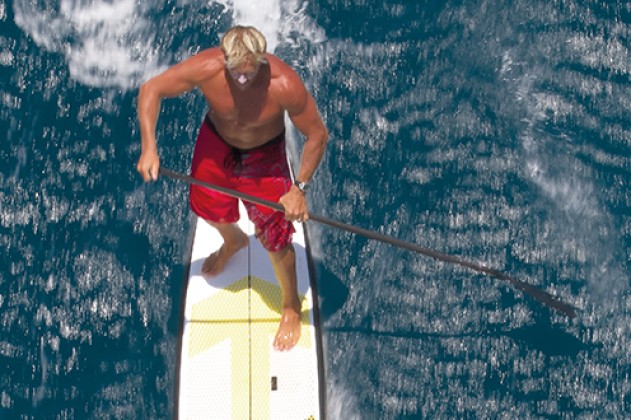RACE & TOURING BOARDS
With Chuck Paterson
At the start of your relationship with stand-up you stood on the shore and beheld the world of possibilities in front of you. Two weeks later you haven’t gone much further than the local beach; the chop is a nuisance, paddling slowly along a featureless shoreline is getting stale and your board slaps about in the wind. What you need to do now is check out a touring or race board and get the fire burning once more.
The first question for the paddler that has the basics of the sport dialled and wants to move onto something more advanced is “What length board should I get?” This depends on your size and preference, for me being a bigger guy I would go towards a 14’, and for the average Joe a 12’6 is pretty common.
Keep in mind the environment you intend to paddle. If you’re going into the ocean where the water is likely to be rougher, you’ll want the extra width (and subsequent stability and comfort) that a 14’ offers over a 12’6. Conversely if you’re paddling flat water like a lake or inside a harbour, this won’t be such an issue.
Even if you don’t have your sights set on racing yet, consider the majority of race classes in your area – usually it’s a fairly big mix but some areas only have a 12’6 class for example and you don’t want to be excluded later on.
Principles of design
The usual beginner SUP board is a real easy paddling board and more of a surf design, but if you look at the difference between that and a race board the nose shape is way different. You’ll see the board packs a lot more volume and the bottom shape carries a displacement hull which glides through water and cuts through chop a lot easier.
You have a couple of different shapes on the top deck. Some are completely flat, and some have a sunken in deck which helps your centre of gravity get a little bit lower but still keep the board narrower, which in the physics part of it keeps the board quicker since a wider board has a longer rail and it takes longer for the water to flow round it.
As a beginner, you don’t want to get caught up in the 25-26 inch boards that the pros are riding, so don’t venture too far out of your own realm, find something in your comfort zone.
Before you put your weight on the race board, study how it floats, you’ll see it sits higher. Get on, and as a rule of thumb, have your feet either side of the handle. Take a couple of strokes and look how the nose is piercing through the water, then look at the tail. If there is a big wake coming off the back then you’re too far back. Every body’s weight distribution is a little different, so customise that foot position.
Planning a downwinder
These boards are good for exploring your local area and once you’re feeling comfortable, consider planning a downwinder with a buddy. I like to make sure the wind is going side shore and maybe even a little bit onshore. Find a launch area that is protected from the wind and surf to paddle out in. Then once you’re into the wind conveyer belt you can start running downwind. For your first time, I would try a 4-5 mile route that ends in a protected cove and not the surf zone so you can get out of the water safely.
Distance paddle sessions give you time to concentrate on your stroke and so develop better rhythm and routine, your cardio fitness improves significantly and your familiarity with foot positions in varying conditions will increase.
When we’re doing downwinders, it’s a little different to paddling in the harbour, so make sure you have a power bar to refuel. Paddle with a buddy and keep it safe as you’re out to sea if something goes wrong.
Training with fuel is a good idea for race preparation so you can get used to a certain powder or water mix. It’s really important to train with fuel to see how your body reacts to it, so if it doesn’t work, you’re not ruining yourself on race day.
INSIDER TRADING…
1. Do plenty of research before buying: demos, reviews, asking friends.
2. Get used to your board before attempting to handle it in even small surf.
3. Take some water and a power bar with you to refuel on downwinders.
4. Shift your weight forward to paddle into the wind to keep the nose down in the chop.
5. Step back a little on a downwinder to better ride the swells.

